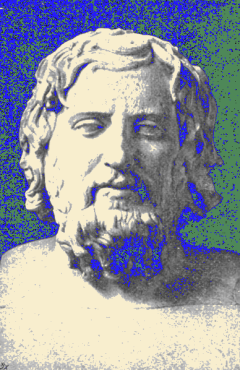Xenophon: Difference between revisions
Jump to navigation
Jump to search
Deleted User (talk | contribs) No edit summary |
m (Text replacement - "Category:People|" to "Category:People") |
||
| (13 intermediate revisions by 3 users not shown) | |||
| Line 1: | Line 1: | ||
{{Stub}} | {{Stub}} | ||
[[File:Xenophon.png|thumb|right|240px|Xenophon]]'''Xenophon''' was a [[Greek]] philosopher, soldier, historian, memoirist, and the author of numerous practical treatises on subjects ranging from horsemanship to taxation. While best known in the contemporary philosophical world as the author of a series of sketches of [[Socrates]] in conversation, known by their Latin title Memorabilia, Xenophon also wrote a Symposium and an Apology which present a set of vivid and intriguing portraits of Socrates and display some sharp contrasts to the better known portraits in the works of Xenophon’s contemporary, [[Plato]]. | [[File:Xenophon.png|thumb|right|240px|Xenophon]]'''Xenophon''' was a [[Athens|Greek]] philosopher, soldier, historian, memoirist, and the author of numerous practical treatises on subjects ranging from horsemanship to taxation. While best known in the contemporary philosophical world as the author of a series of sketches of [[Socrates]] in conversation, known by their Latin title Memorabilia, Xenophon also wrote a Symposium and an Apology which present a set of vivid and intriguing portraits of Socrates and display some sharp contrasts to the better known portraits in the works of Xenophon’s contemporary, [[Plato]]. | ||
[[Category:People]] | |||
[[Category:Philosophy]] | |||
Latest revision as of 16:42, 12 December 2022
Xenophon was a Greek philosopher, soldier, historian, memoirist, and the author of numerous practical treatises on subjects ranging from horsemanship to taxation. While best known in the contemporary philosophical world as the author of a series of sketches of Socrates in conversation, known by their Latin title Memorabilia, Xenophon also wrote a Symposium and an Apology which present a set of vivid and intriguing portraits of Socrates and display some sharp contrasts to the better known portraits in the works of Xenophon’s contemporary, Plato.
